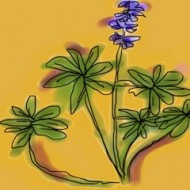The Dry Garden: Letting go
There may be something more painful than letting go of a garden built from scratch and largely by hand, but I haven’t experienced it. Yet after 12 years in the only home I have known in Los Angeles, it’s time to move. The young oaks, toyon, ceanothuses, sages and fruit trees will need to ingratiate themselves to the new owners, or die. Signs painted by local schoolchildren will stay. My father’s ashes along with the graves of three beloved dogs cannot come with me. They are all bound up in the plants.
Yet handing over the garden isn’t difficult because of sacred dust. It’s the living that haunt me. It’s unexpectedly intense affection for the defiantly stray cat that I have taken to feeding. It’s hoping that the mourning doves that I have fed and supplied with fresh water every day since July 1998 find new food and new water. …
The Dry Garden: Hesperaloe
Mushy leaves of South African aloe can't do this. The fibers of the Chihuahuan Desert native Hesperaloe are used in cordage.
Four years ago, I learned that a lady up the street whom I had for six years referred to as Chloe was named Cheryl. In much the same fashion, I only recently learned that a plant in my parkway that for five years I have called nolina is in fact Hesperaloe parviflora.
I learned this while singing the plant’s praises to a gardening class that had dropped by to see my rain catchment system. If there is comfort in this, it’s that hesperaloe is one heck of a plant by any name.
A member of the agave family and native to the Chihuahuan Desert, hesperaloe’s tolerance for cold (to 12 degrees) and heat (100-plus degrees) means that the plant can cope easily with what our Mediterranean climate can …
The Dry Garden: She’s back
I met Dryden Helgoe six years ago when she was part of team behind a new landscape at Kidspace Children’s Museum in Pasadena. Shortly afterward, I worked with her on a playground plan for a school garden. During both encounters, she was inscrutable: gracious, spookily competent and distractingly beautiful as a Botticelli angel. Then, by the end of 2005, she was gone — off to start a family.
During the intervening years, I wondered more than once if the choice of stay-at-home motherhood would retire Helgoe. When I met her, she was a rising star. The University of Oregon landscape architecture graduate had a year at the Olin Studio in Philadelphia and five with Nancy Goslee Power & Associates in Santa Monica. Helgoe’s disappearance from the scene left a void.
Click here to keep reading about Dryden Helgoe’s return to landscaping in The Dry Garden column of the Los Angeles …
The Dry Garden: 275 lawns down, 79,725 to go in Long Beach
Plaudits, not sprinklers, were flowing this week when the Heal the Bay president, a Surfrider Foundation policy director, a vice mayor and water company general manager gathered in the garden of a Long Beach handyman to ooh and aah over the salvia.
They were there to praise citizens of Long Beach who embraced the first of two rounds of rebates — $2.50 per square foot lawn converted to low-water garden — that started in April. It stands to reason that clean-ocean advocates would appreciate how important it is to check the stream of pesticide and fertilizer pollution that runs into the Pacific from lawn-sprinkler overflow. But what has dazzled everyone familiar with the Beautiful Long Beach Lawn-to-Garden Incentive Program is how citizens of this beach city have been so ready to do their part. The first day that the Long Beach Water Department began accepting applications, conservation specialist Joyce Barkley …
A decade of change
I had the honor this week of being a guest speaker before both the California Native Plant Society and Lili Singer’s Garden Talk audience at the Los Angeles County Arboretum and Botanic Garden. The subject: A decade of gardening, during which time I took my 8,000 square foot lot near downtown Los Angeles from a conventional turf & mow model to a Mediterranean climate/native garden that runs largely on local rainfall and sees power tools only every two years during pruning season. This photo essay captures that progression. My apologies to the CNPS audience, who last Sunday endured a PowerPoint failure. Here, belatedly, are the images. My thanks to Steve Hartman of CNPS, Lili Singer of the Theodore Payne Foundation and Jill Berry, Ted Tegart and Cynthia Vargas of the Arboretum for challenging me to put together this photo diary, then helping it come together. To see the full photo …
« go back — keep looking »

